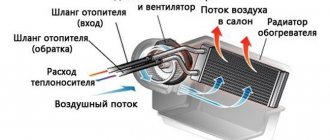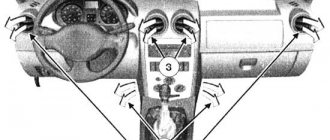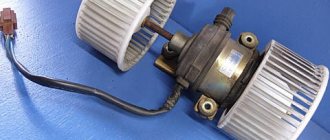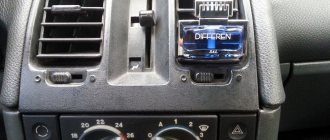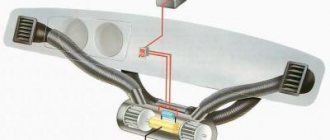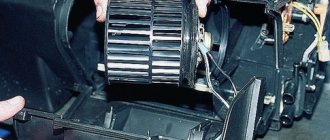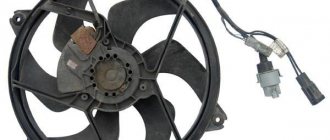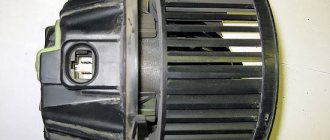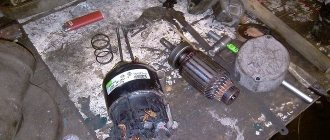I would be glad for advice... because... in progress…
I found the reason in a place where I really don’t like to climb due to the genius of the French minds, who thought of placing something in the wettest place of the car body, which is very difficult to get into without touching the battery...
Therefore, it was easier for me to disassemble the entire dashboard... roughly speaking, the floor of the car than move the battery to check there... I think everyone has already guessed what we’re talking about...
But I’m glad that this happened because now I have completely inspected all the wiring and in most units I finally replaced the burnt out light bulbs with new ones - now everything lights up so unusually - I I’ve already forgotten what it’s like =) But more on all this in the second part of the article...
1 part
Two weeks ago, one fine Saturday afternoon after work, I came to the parking lot to my car, and the windshield seemed to be fogged up from the inside...
It’s strange, I thought... I opened the door... I smelled something like burnt wire insulation, but I didn’t pay attention... I thought it was coming from somewhere, maybe from the street. I started it up... turned the heater on to maximum - I think now the glass will quickly fog up, but that was not the case! I don’t hear the usual hum of the stove.
I turned off the music... I twist and turn the speed control, but it’s a bolt... it doesn’t work for nothing, and the wiring stinks more and more...
Attempts to pull the fuses in the cabin led to nothing except that at maximum speed + when the air conditioning button was turned on, the fan barely rustled with all its might - there was still a persistent thought that the stench was not from the car, but from the street... But then - fogged up windshield... the stench and the non-working fan gave me the idea that the fan had died... shorted out... who the hell knows...
And on this wonderful winter day I lowered the windows (the smell was getting stronger and stronger) and drove home. About a third of the way through, the fan stopped completely.
I arrived at the garage, removed the terminals and left the problem for tomorrow...
Fundamentally, I don’t want to go to an electrician and pay money yet... until I tried to solve the problem myself.
On Sunday morning, armed with the knowledge of the Internet, I went with my girlfriend and went to the garage...
As a “professional” in electronics, who doesn’t understand anything about it at all, for some reason I decided to look for the problem directly in the fan itself... Although the manual describes step by step the actions of what and in what sequence, and actually everything starts from the interior... But as the most the smart one did not go around the mountain, but went straight...
I decided to go straight into the fan... What do I want to say? It took me a week to get there =))))) At first I wrote it here, but then I decided that it was worthy of a separate article. The epic with the windshield wiper leashes
As it is written in many logbooks, REMOVING THE LEASERS OF THE WIPERERS IS ALMOST THE MOST DIFFICULT IN SUCH REPAIRS! Hope… )))
Hope… )))
So, what I have found out so far:
— the air conditioning and recirculation lamps light up when the button is pressed;
— when turning the speed control (6 speeds), somewhere under the hood some relay clicks at each position, but the fan is silent... I haven’t found this relay yet... but I concluded that if the relay clicks, then in theory there is current through the knob It's running and it's working - am I right or wrong?
— in the interior before the breakdown there was a smell of melted wiring... perhaps I found where the smoke was coming from - the fog lights were installed by the previous owner, bypassing the standard wiring through the relay: the wires rubbed against the elements of the body frame and periodically shorted each other with sparks and smoke... perhaps the smell was from them as an option ... or maybe not... and there was a short circuit even with the ignition off. The wires of the horn relay were also shorted - it was also connected bypassing the standard wiring. And the most intriguing thing about this is that above these relays, 1.5 cm higher, there is a gas reducer and, in fact, all the sparks and smoke on it - and I drove like this for a long time... and I suspected that there was a current leak somewhere because . The battery was discharged suspiciously steadily... The fuse melted under the hood on the driver's side - replaced it. The chain is also a collective farm. I haven’t figured out what it’s responsible for yet... At the moment I’m eliminating defects with the wiring... plus it took me a long time to figure out which wires are responsible for what... It has nothing to do with the heater fan... let’s forget about it for now;
"Symptoms" of a breakdown
First of all, let’s identify all the main signs that may indicate that the motor is already faulty.
- The fan starts to run very slowly.
- The speeds begin to gradually disappear. Most often, not all of them disappear at once, but some, separately. Then they fail—they don’t work at all.
- You can smell the wiring inside the car.
- Starting the stove is associated with significant difficulties. So, car enthusiasts force it to work only after a “hit” in the lower torpedo on the right.
- Finally, the motor stops starting altogether. This is the most extreme case. If this breakdown is discovered, repairs must begin immediately.
To find out for sure that the Renault Megane 2 heater fan is not working, you need to know a little more about diagnosing the car fan.
Important points
When replacing a stove fan with a Renault Megane, you need to remember the nuances that, at first glance, seem insignificant, but are actually very important. Here they are:
- as stated above, repairs begin with removing the side trim. But it is not always possible to remove it without problems, even if the central latch has successfully opened. After all, the pad sits in its niche so tightly that you simply cannot catch on it. There is only one way out: use a knife with a thin blade. The knife is carefully inserted into the slot and the cover is raised. But here you need to be careful not to break the fragile latches along the edges of the lining;
- pulling out the axle on the brake rod is not an easy task: it fits very tightly, and, moreover, in some cases it also rusts, literally welding to the rod. If this is exactly what happened, WD40 liquid will help. You need to generously lubricate the rust with this composition and wait 15 minutes. Even the rustiest axle can be removed without problems;
Even a novice car enthusiast can replace a faulty fan on a Renault Megane of the second or third model. Certain difficulties arise only when removing the unscrewed electric motor. But if you remove it as shown in the instructions, the impeller and motor will remain intact.
More about diagnostics
The operating diagram of the heating device on Renault Megane 2 is standard. Outside air flows through the radiator. Then, thanks to an electric fan that operates in four modes, air is supplied to the interior of the car. Now let's outline several key diagnostic techniques.
When the control handle has already been turned, but no noise is heard from the running electric motor, drivers usually immediately check the fuse. It is important to find out whether it is intact and whether it is capable of protecting this electrical circuit. The fuse is located directly in the passenger compartment. Look for it in the block, which is located below, near the front panel, on the left side. If the 30 amp fuse is blown, the cause of the failure must be discovered.
If the electric fan does not operate at a certain speed, you will have to arm yourself with a multimeter. With its help, you will be able to detect which resistance has burned out. Next there are several paths. You can solder a burnt-out resistor yourself, or you can replace the entire resistor block. If the resistors do not burn out, the problem is in the switch that controls the fan. And it needs to be changed.
Did you find out that the fuse is intact? Then you need to check whether the electric fan motor is working. For this purpose, it is connected to the battery directly. To get to the desired area, you will have to lift the glove compartment above the front panel or remove it altogether. Then the plug is disconnected, plus the battery is connected to the terminal from which the black and blue wire comes out. Another contact is made to the negative terminal. When the electric motor is working properly, after such manipulations it begins to operate at maximum speed. If the engine does not function, it must be replaced.
Replacement and repair of Megane 1, 2 and 3 stoves
The interior heating system of a Renault Megane car consists of a radiator, a fan, air ducts and an electronic control unit with sensors. The stove performs the important function of heating the cabin during the cold season, and in order to make your stay in the cabin comfortable, it is necessary to monitor its condition and carry out diagnostics and repairs in a timely manner.
What faults may be present in the system?
The most common breakdowns of Renault Megane are:
- the fan does not turn on;
- no hot air enters the cabin (it does not heat well);
- there are extraneous noises during operation;
- other breakdowns (sensors, buttons, air ducts).
Types of breakdowns and ways to fix them
- The fan is not working. The first thing you need to do is check the integrity of the contacts and wiring, as well as fuses and sensors. If all connections are in order and the fuses are not blown, then the reason that it does not turn on is the failure of the motor.
- Hot air does not enter the cabin. There may be several reasons why the stove does not heat, or heats very poorly. First of all, you should check the serviceability of the air damper, air ducts, and change the cabin filter. If these measures do not help, it is possible that there is no coolant flowing into the radiator (the inlet pipe is cold) or the radiator is clogged.
- The heater whistles. If you hear howling and grinding noises coming from the stove when the stove is on, this means that the fan needs to be repaired. Most likely, the bearings in it are worn out or the motor brushes are worn out.
- Other malfunctions. One of the most common breakdowns is that the fan only works at one speed and does not heat at the others. In this case, you should look for burnt fan resistance (sensors) using a multimeter. A burnt sensor that does not turn on should be replaced with a new one. If you don’t want to solder it, you can completely change the entire resistance block with sensors. The stove may not heat due to a broken switch in the cabin. Sometimes air dampers fail, blocking the air flow.
Step-by-step instructions: the most affordable option with photos
Now we will look at the most intelligible guide: we will learn how to disassemble the stove in Renault Megane 2. We will be helped by good, clear photographs that are supplied with each step. Be careful, then this instruction will help you. You will be able to quickly remove the fan from your car’s heater without asking for help.
1. First of all, you need to remove the cover. Proceed with extreme caution. Be careful not to overdo it, otherwise you risk breaking the panel. The key latch is located in the center of the surface. You just need to pull it back.
2. Now look at what picture should open before you. You need to move towards the location of the pedals. Be sure to have a flashlight with you for work. The best solution is to take a headlamp.
3. In the third stage, it's time to get rid of the brake light button. Turn it carefully counterclockwise and then remove it.
4. Now you need to remove the connector from the gas pedal. To do this, press on the right along the way, from the flat side. Most often you have to use a screwdriver as a lever for prying. Then comes the turn of the brakes. Disconnect the lock washer, remove it from the rod, and then lower the lock down. The axle is removed as it moves to the right.
5. Locate the four nuts on the pedal assembly mounting. Unscrew them and remove the assembly. You will need a key for 13.
6. Look even deeper. In the very depths you will see a motor. It's on top. To get to it, you need to unplug another connector. Its latches are located on the end sides.
7. At this stage, the node should be expanded.
8. The next step may be difficult, so be extremely careful. We are interested in the connector from which two thick wires come. It needs to be removed. The latch is pulled out from below. The direction of movement is from the center of the node. The connector opens like a luggage compartment lid. To pull it out, you will have to carefully move it to the left along the axis.
9. Now the turn of the most difficult stage has come. It is necessary to remove the unit, and the brake rod becomes an insurmountable obstacle. You can do everything according to the rules, but it will take a very long time. Car enthusiasts have been thinking for a long time about how to cope with the problem and optimize the process. Attempts to insert the rod into one of the grooves in the desired direction were unsuccessful. But there is a better solution: the assembly can be inserted with the utmost care between the brake rod and the heating pipes. This is only possible if a certain position of the motor is observed.
When you need to return everything back, the algorithm is the same.
Often it is enough to disassemble the fan to solve the problem of a non-working stove, to detect a problem or malfunction. The main thing is to act as carefully as possible so as not to damage the elements.
Conclusion
If you have to change the motor, you will also have to additionally purchase a control unit for it. In most cases, the resistor and terminals in the connector burn out. Please note that control units are quite expensive. The optimal solution is to first disassemble the panel and find out exactly what needs replacing.
It is very important to undergo maintenance on time so that no difficulties or unforeseen problems arise.
Renault Megan 2 is considered a reliable car. And the heating system is no exception. But it is also common for her to fail. The first to suffer is the heater fan, which is responsible for pumping air into the car interior. How to recognize its breakdown?
Replacing a heating fan on a Renault Megane
In order to change the furnace fan, we will need the following tools:
- Phillips screwdriver;
- flat blade screwdriver;
- set of open-end wrenches;
- set of socket wrenches;
- flashlight.
Replacement sequence
To cope with the work in a short time, you need to adhere to the following sequence of actions:
- There is a plastic trim on the dashboard, to the left of the driver. It is held on by several latches. The main clip is located in the center of the pad, so you need to press there. After a characteristic click is heard, the lining is carefully pulled out.
The side trim on the Renault Megane dashboard is held on by six latches. Access to the brake light button is provided. It is removed manually. The button just needs to be turned clockwise and it will fall out of its niche.
To remove the brake light button, simply turn it clockwise. The next step is the brakes. The lock washer is carefully pryed off with a flat screwdriver, lifted and removed from the rod. The latch can now be lowered. And to remove the axle, just pull it to the right.
The axle on the Renault Megane brakes is removed after removing the lock. The pedal assembly is held on by four nuts at “13”. They are unscrewed with a regular open-end wrench, after which the pedal assembly is removed.
To remove the Renault Megane pedal assembly, you will have to unscrew 4 nuts by 13. This opens access to the electric fan motor. However, it is blocked by the wiring harness. Its connector is on the left side. It has latches. In order to remove the connector from the socket, you need to squeeze these latches and pull the wires towards you.
To remove the wiring harness, its latches need to be squeezed and pulled towards you. The electric motor with the fan is held on by plastic clips. To remove it, you need to press down on the locking tab and then turn the motor counterclockwise.
To disconnect the electric motor together with the fan, it should be turned counterclockwise. The brake rod prevents the removal of the electric motor and fan. In order to remove the motor without damaging the impeller, it should be rotated as shown in the photo below. Dismantling is only possible in a certain position.
This is the only way to remove a motor with a heating fan from a Renault Megane
- After removal, the worn fan is replaced with a new one and the heating system and dashboard are reassembled.
Video: changing the heater fan on Renault Megane
Step-by-step dismantling of the stove
Be careful when removing the furnace fan on the Renault Megan 2. Then all the work will go extremely quickly and without problems.
- Carefully remove the pad without any extra effort. The latch is located exactly in the center of the dashboard.
- A curious landscape will open before you. Arm yourself with a headlamp and head towards the pedals.
- Now the elimination of the stop lights control button. To do this, you need to turn it counterclockwise and then remove it.
- Next in line is the gas pedal connector. To do this, press down on the flat side. For prying, a screwdriver is useful as a lever. When the gas is finished, move on to the brake. It is held in place by a lock washer. The connector must be removed from the rod and the lock released. Remove the axle as you go to the right.
- The picture below shows the mounting points for the pedal assembly. To remove them, use key 13.
- After all these steps you will see a cherry, or rather a stove fan. To get to it, you need to disconnect another connector. The latches are visible on the end sides. At this stage, you want to drop everything and go to a car service center. And how far can you go in a jacked-up car, I wonder? So we continue to dismantle the stove fan.
- The knot must be turned counterclockwise.
- Now you need to remove the connector from which two thick wires extend. Pay attention to its position. The procedure may be difficult. Since we are in contact with electrics, any movement with an error will make the operation of the vehicle dangerous. Removing the connector must begin from the center of the assembly with careful removal to the left along the axis.
- Next, you need to route the motor between the brake rod and the radiator pipes. This is not easy to do, but it is possible. It is important to manually turn the Renault Megan 2 heater fan to the position shown in the picture above. And then with great difficulty, but such a procedure will bring success.
We repair the system with our own hands
Many repairs can be done independently, both on gasoline and diesel models. Having found out the reason for the poor operation of the stove, it is necessary to eliminate the malfunction.
Removing the fan on Renault Megane of all three generations is not very easy. In order to dismantle a fan with a motor that does not turn on, you must perform the following steps:
- Remove the plastic cover that is located near the pedals (on the right). This must be done carefully so as not to damage the fragile plastic latches. Turn the brake light sensor counterclockwise and remove it.
- Disconnect the gas pedal connector and remove the brake axle, first removing the lock washer and lowering the lock down. Using a 13mm wrench, unscrew the nuts securing the pedal assembly and dismantle it.
- Inside the resulting niche we find the required part (for this you need to use a flashlight). Remove the fan assembly by disconnecting the connector.
- In order to remove the fan, you need to press the lock and turn it counterclockwise. It is quite difficult to remove the part from its normal location, since the brake rod is in the way. You can carefully remove it from between the antifreeze tubes. You must act extremely carefully so as not to damage the heater impeller. Inspect the part for blockages and mechanical damage, due to which it may not turn on.
Replacing the radiator is necessary if it is leaking or clogged. In order to repair the radiator, you need to perform the following steps:
- Disconnect the wires from the battery, starting with the negative one. Next, pinch the hoses so that the coolant does not leak out, and open the hatch cover that leads to the lower casing.
- Open the flap on the instrument panel, which is located on the side. Now disconnect the sensor and headlight range control connector and set the mode switch to the minimum damper opening.
- Disconnect the air ducts and route the hose down, also remove the front part of the air duct that distributes the air flow, and move the wiring harness to the side. Bend back the interior carpet and remove the lower part of the casing.
- Then unscrew the four bolts of the instrument panel and open it. To prevent coolant from leaking out of the radiator onto the ground, place a suitable container underneath.
- Now move the radiator, unscrew the clamps, remove the radiator hoses and remove the part.
- The heater is installed in the reverse order. At the same time, do not forget to install new gaskets and connect all wires and sensors. Make sure the radiator turns on and heats properly. Install protective plastic elements only after the system has been tested, the sensors are working and no coolant leaks have been detected.
Climate control fan not working
Fuse and fan motor.
There may be situations when, after turning on the stove and air conditioner, the indication is activated, but air is not supplied. At some point, the airflow does not work correctly - it switches to the legs.
Here you need to inspect the fuses and relays. Most often, the fuse-link burns out, and it is enough to replace it with a new device.
The diagram shows where the cooling fan fuse is located on a Ford Focus.
Sometimes when you turn on the air conditioner and heater, no air flows into the cabin, but the display works normally. If the airflow is not activated, the reason may be in the motor of the device.
Cruise control testing often shows no errors, but the motor may still not work. For accurate diagnosis, the use of scanners and special devices is required.
How to replace the heater fan and additional resistor on a Ford Focus II, see below.
Fan speed control unit.
Another situation is also possible. The climate control works, but after switching on a “whistle” appears, and after a while the air does not enter the cabin at all.
First you need to check the fuses and the fan. If these elements are intact, the reason lies in the electronics, namely the fan speed control unit. After replacing it, the system is likely to work.
